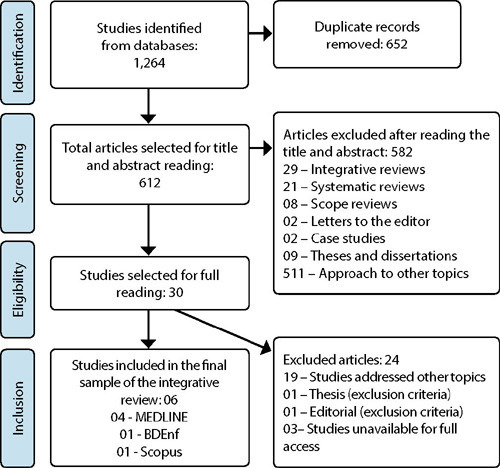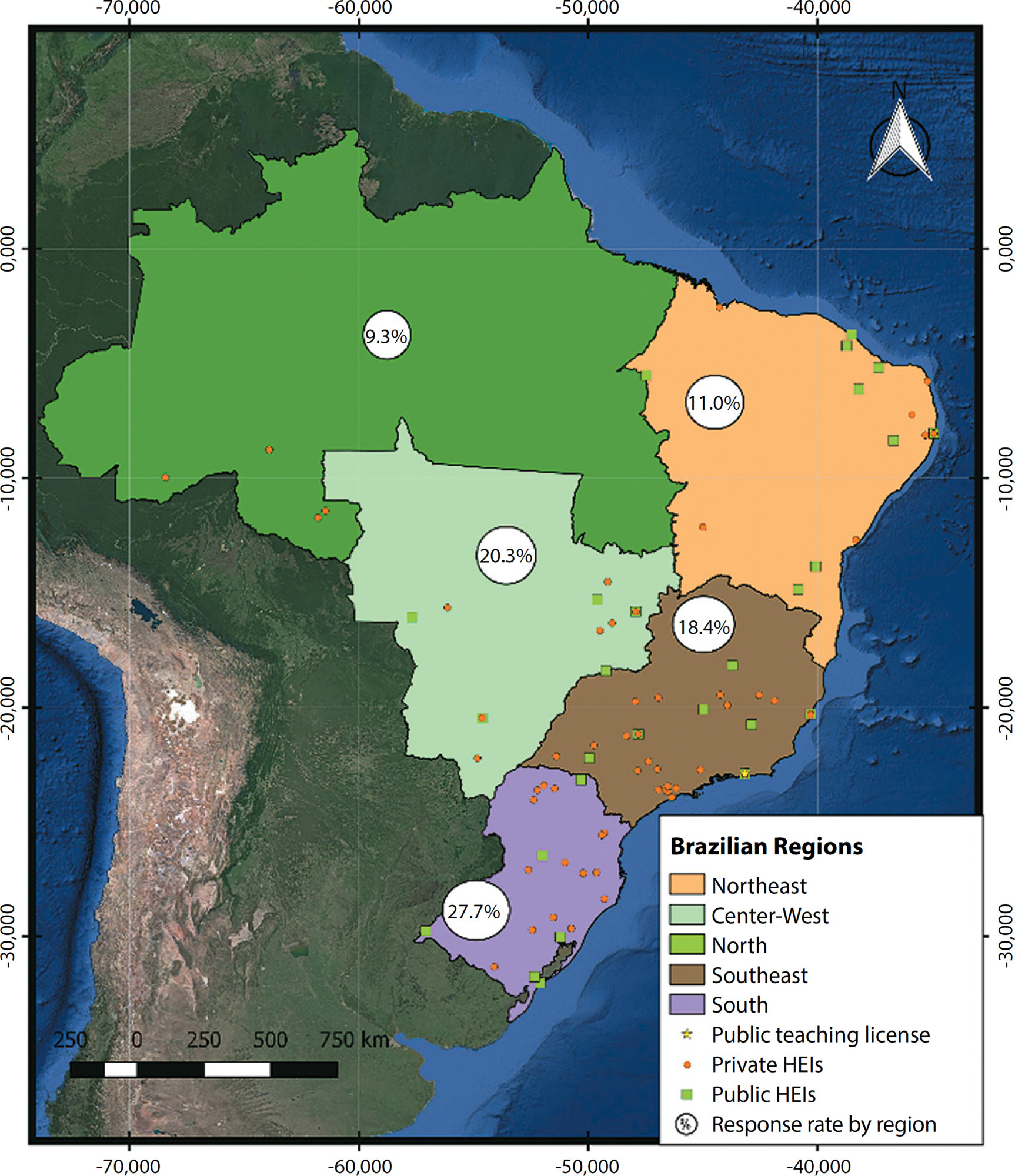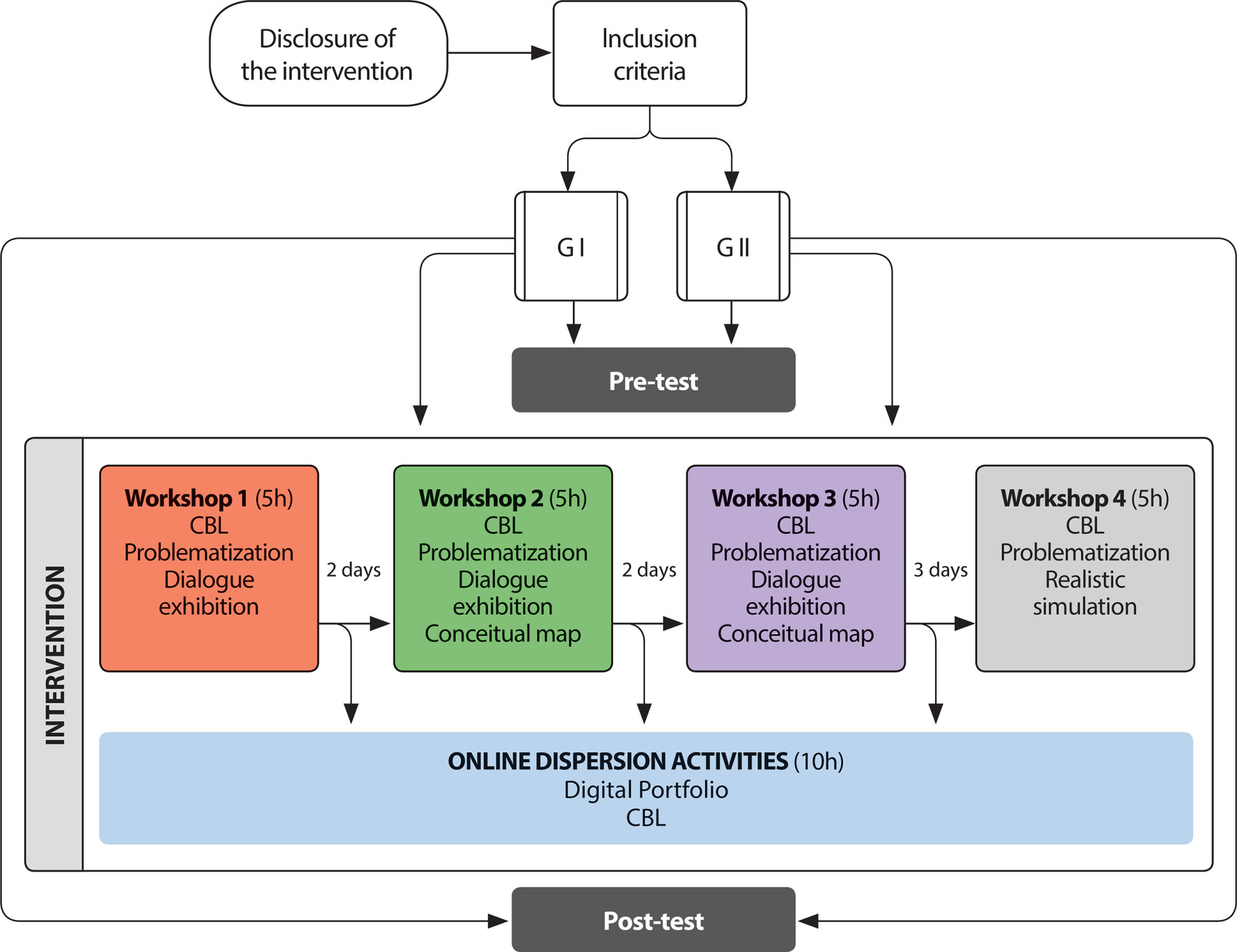-
ORIGINAL ARTICLE03-11-2024
Ethnically distinct populations and coping with violence against children in the COVID-19 pandemic
Revista Brasileira de Enfermagem. 2024;77:e20230350
Abstract
ORIGINAL ARTICLEEthnically distinct populations and coping with violence against children in the COVID-19 pandemic
Revista Brasileira de Enfermagem. 2024;77:e20230350
DOI 10.1590/0034-7167-2023-0350
Views0See moreABSTRACT
Objective:
To identify policies and programs adopted by a Brazilian municipality to address violence against children during the COVID-19 pandemic.
Method:
A qualitative documentary study. The study setting was the municipality of Ananindeua, Pará, Brazil. Data was collected from official websites between November 2021 and February 2022. Thematic content analysis was used with the support of webQDA software.
Results:
Three empirical categories emerged: a) Impacts of the COVID-19 pandemic on violence against children; b) Action strategies for tackling violence against children in the COVID-19 pandemic; c) Evaluation indicators and targets for action strategies for tackling violence against children.
Final considerations:
The documents revealed few direct mentions of children, especially traditional populations; they presented superficial and ineffective evaluations of the policies and programs adopted, using exclusively quantitative indicators.
-
ORIGINAL ARTICLE03-11-2024
Experiences of women with physical disabilities in labor and delivery assistance
Revista Brasileira de Enfermagem. 2024;77:e20230290
Abstract
ORIGINAL ARTICLEExperiences of women with physical disabilities in labor and delivery assistance
Revista Brasileira de Enfermagem. 2024;77:e20230290
DOI 10.1590/0034-7167-2023-0290
Views0See moreABSTRACT
Objective:
To understand the meaning attributed by women with physical disabilities to the health care received and expected during labor and delivery.
Methods:
Qualitative study, based on Social Network Theory, conducted through an online workshop in April 2022, with the participation of six women with physical disabilities. Data, collected through the focus group technique, underwent thematic content analysis with the assistance of the IRaMuTeQ tool.
Results:
Three thematic categories emerged: Challenges experienced during pregnancy; The experience within the maternity ward; and, The importance of social networks. The assistance provided by healthcare professionals sometimes differed between what was expected and what was received by women with physical disabilities during labor and delivery.
Final Considerations:
Experiences were predominantly negative, resulting from inappropriate professional conduct due to ableist attitudes. Support from members of social networks is crucial for preventing stressors.

-
03-11-2024
O uso da ultrassonografia point-of-care na prática clínica do enfermeiro como alicerce para a segurança do paciente
Revista Brasileira de Enfermagem. 2024;77:e77suppl0201
Abstract
O uso da ultrassonografia point-of-care na prática clínica do enfermeiro como alicerce para a segurança do paciente
Revista Brasileira de Enfermagem. 2024;77:e77suppl0201
DOI 10.1590/0034-7167.202477suppl0201pt
Views0Recentemente, mais um caso de dano grave associado ao cuidado em saúde foi reportado pela mídia. Uma jovem grávida teve a mão e o punho amputados depois de dar à luz ao terceiro filho em um hospital do Rio de Janeiro(). Após o incidente ocasionado pelo acesso vascular, a mulher apresentou hemorragia e foi reinternada.Os […]See more -
REVIEW03-11-2024
Continuing nursing education actions in the face of homophobia: an integrative review
Revista Brasileira de Enfermagem. 2024;77:e20230094
Abstract
REVIEWContinuing nursing education actions in the face of homophobia: an integrative review
Revista Brasileira de Enfermagem. 2024;77:e20230094
DOI 10.1590/0034-7167-2023-0094
Views0See moreABSTRACT
Objectives:
to analyze continuing nursing education actions in the scientific literature in the face of homophobia.
Methods:
an integrative literature review with structured search in June 2022 in eight databases, using the descriptors Nursing Education, Homophobia, Sexual and Gender Minorities. Final sample consisted of six primary studies.
Results:
continuing nursing education actions are supported by strategies such as use of teaching materials, lectures, case studies and focus groups, addressing content such as gender identity issues and affective-sexual orientation, health disparities and their relationship with homophobia in healthcare settings.
Final considerations:
carried out in various healthcare settings, continuing education actions proved to be successful in raising nurses’ awareness in facing homophobia in health services, however, their expansion is necessary to create health spaces that meet the specific needs of these people.

-
03-11-2024
The use of point-of-care ultrasound in nurses’ clinical practice as a foundation for patient safety
Revista Brasileira de Enfermagem. 2024;77:e77suppl0201
Abstract
The use of point-of-care ultrasound in nurses’ clinical practice as a foundation for patient safety
Revista Brasileira de Enfermagem. 2024;77:e77suppl0201
DOI 10.1590/0034-7167.202477suppl0201
Views0Recently, another case of serious harm associated with healthcare was reported by the media. A young pregnant woman had her hand and wrist amputated after giving birth to her third child in a hospital in Rio de Janeiro(). After the incident caused by vascular access, the woman suffered hemorrhage and was readmitted.The harm caused to […]See more -
03-08-2024
A enfermagem como protagonista no enfrentamento da hesitação e recusa vacinal
Revista Brasileira de Enfermagem. 2024;77:e77suppl101
Abstract
A enfermagem como protagonista no enfrentamento da hesitação e recusa vacinal
Revista Brasileira de Enfermagem. 2024;77:e77suppl101
DOI 10.1590/0034-7167.202477suppl101pt
Views0Desde a década de 1970, o Ministério da Saúde do Brasil instituiu o Programa Nacional de Imunização (PNI), que precedeu o Sistema Único de Saúde e que lhe foi incorporado e fortalecido, devido ao modelo descentralizado aos municípios, mas de comando único ao nível central. Seu objetivo era e ainda é coordenar as ações de […]See more -
03-08-2024
Nursing as a player in tackling vaccine hesitancy and refusal
Revista Brasileira de Enfermagem. 2024;77:e77suppl101
Abstract
Nursing as a player in tackling vaccine hesitancy and refusal
Revista Brasileira de Enfermagem. 2024;77:e77suppl101
DOI 10.1590/0034-7167.202477suppl101
Views1Since the 1970s, the Brazilian Ministry of Health established the Brazilian National Immunization Program (PNI – Programa Nacional de Imunização), which preceded the Brazilian Health System and which was incorporated and strengthened due to the decentralized model to municipalities, but under single command at central level. Its objective was and still is to coordinate vaccination […]See more -
02-26-2024
Nurse Navigator of Cancer Patients: contributions to the discussion on the national stage
Revista Brasileira de Enfermagem. 2024;77(2):e770201
Abstract
Nurse Navigator of Cancer Patients: contributions to the discussion on the national stage
Revista Brasileira de Enfermagem. 2024;77(2):e770201
DOI 10.1590/0034-7167.2024770201
Views0The professional practice of patient navigation is incipient in Brazil and, therefore, a broad discussion with various sectors of society is essential, which is the main purpose of this editorial. Shall we start with the story.Patient navigation was defined in 1989 as a community-based service delivery intervention aimed at appropriately promoting access to diagnosis and […]See more
-
ORIGINAL ARTICLE04-14-2023
Artificial intelligence in the analysis of emotions of nursing students undergoing clinical simulation
Revista Brasileira de Enfermagem. 2023;76:e20210909
Abstract
ORIGINAL ARTICLEArtificial intelligence in the analysis of emotions of nursing students undergoing clinical simulation
Revista Brasileira de Enfermagem. 2023;76:e20210909
DOI 10.1590/0034-7167-2021-0909
Views0See moreABSTRACT
Objective:
to assess nursing students’ emotions undergoing maternal-child clinical simulation.
Methods:
an observational study, carried out between June and July 2019. The Focus Group technique was used, with 28 nursing students, randomly distributed into three groups, with qualitative (Bardin technique) and quantitative data (Artificial Intelligence) analysis, to analyze emotions through facial expressions, tone of voice and description of speeches.
Results:
we defined two categories: “It was not easy, it was very stressful”; and “Very valuable experience”. In Artificial Intelligence, emotional distribution between face, voice and speech revealed a prevalence of negative valence, medium-high degree of passivity, medium power to control the situation and medium-high degree of obstruction in task accomplishment.
Final considerations:
this study revealed an oscillation between positive and negative emotions, and shows to the importance of recognizing them in the teaching-learning process in mother-child simulation.

-
04-26-2021
Content validity of the nursing diagnostic Breathing Pattern, Ineffective, in children with congenital heart defects
Revista Brasileira de Enfermagem. 2021;74:e20190844
Abstract
Content validity of the nursing diagnostic Breathing Pattern, Ineffective, in children with congenital heart defects
Revista Brasileira de Enfermagem. 2021;74:e20190844
DOI 10.1590/0034-7167-2019-0844
Views0See moreABSTRACT
Objective:
To estimate the content validity of the nursing diagnostic Breathing Pattern, Ineffective, in children with congenital heart defects.
Method:
Methodological study in two stages: 1) integrative literature review; 2) content validation, with 23 nurses. An instrument with 10 related factors and 21 defining characteristics for data collection was used. The analysis by the evaluators was carried out using the relevance criteria. The Content Validity Index was used. Valid results were those above 0.9 with a Wilcoxon test above 0.05.
Results:
The final proposal incorporates nine from the ten causal factors. From them, five do not belong in the NANDA-I list. Regarding the defining characteristics, they were all considered to be relevant, and five are not among the list of signs and symptoms of the NANDA-I taxonomy.
Conclusion:
The findings of this study include specific elements of the pediatric population with congenital heart defect which are not present in the structure of the diagnostic being studied.
-
06-11-2021
Influence of social determinants of health on skin to skin contact between mother and newborn
Revista Brasileira de Enfermagem. 2021;74:e20200138
Abstract
Influence of social determinants of health on skin to skin contact between mother and newborn
Revista Brasileira de Enfermagem. 2021;74:e20200138
DOI 10.1590/0034-7167-2020-0138
Views0See moreABSTRACT
Objective:
to analyze the association of skin-to-skin contact and social determinants of health.
Methods:
this is a cross-sectional study with 187 medical records of newborns from a reference rooming in in northeastern Brazil. An instrument with maternal and neonatal data was used. Analysis was descriptive and inferential statistics. For the associations, a chi-square test was used to measure strength, an Odds Ratio was calculated, with a 95% confidence interval.
Results:
62% of newborns who made skin-to-skin contact at birth were eutrophic, full-term, Apgar > 7, mothers with prenatal care and without abortion. The determinants associated with non-skin-to-skin contact were preterm (CR=3.2;95%CI: 2.72-18.98); 1st minute Apgar < 7 (CR:2.9;95%CI: 2.38-3.06), cesarean section (CR:8.4;95%CI: 4.29-16.57), and unhealthy NB (CR 12.7;95%CI: 4.9-32.67). We used STROBE guidelines.
Conclusion:
skin-to-skin contact was influenced by gestational age, Apgar, delivery, and newborn health.
-
07-09-2021
Sexuality and assessment of physical and psychological symptoms of older adults in outpatient care
Revista Brasileira de Enfermagem. 2021;74:e20200998
Abstract
Sexuality and assessment of physical and psychological symptoms of older adults in outpatient care
Revista Brasileira de Enfermagem. 2021;74:e20200998
DOI 10.1590/0034-7167-2020-0998
Views0See moreABSTRACT
Objective:
to analyze the relationship between affective and sexual experiences and the intensity of physical and psychological symptoms of older adults.
Methods:
observational, cross-sectional and analytical study, guided by the STROBE tool, carried out in a geriatric outpatient clinic. Sociodemographic and health questionnaire, Affective and Sexual Experiences Scale for Elderly, Edmonton Symptom Assessment Scale were used. Descriptive statistical analysis and Spearman correlation were performed.
Results:
forty-five older adults participated, with a mean age of 73.8 years; most (91.1%) were married. The highest averages of symptom intensity were pain (4.9), anxiety (4.8), drowsiness (4.5), and a feeling of well-being (4.5). There was a negative correlation between sadness and the dimensions of sexual activity and affective relationships (rs=-0.365; p=0.014 and rs=-0.386; p=0.009) and between anxiety and sexual activity (rs=-0.308; p=0.040).
Conclusion:
as sadness increases, affective and sexual experiences are less. The greater the anxiety intensity, the lower the sexual experiences.
-
ORIGINAL ARTICLE05-21-2021
Simulation in nursing baccalaureate courses of Brazilian educational institutions
Revista Brasileira de Enfermagem. 2021;74:e20190730
Abstract
ORIGINAL ARTICLESimulation in nursing baccalaureate courses of Brazilian educational institutions
Revista Brasileira de Enfermagem. 2021;74:e20190730
DOI 10.1590/0034-7167-2019-0730
Views0See moreABSTRACT
Objective:
to characterize simulation practices in nursing courses in Brazil, considering the attributes developed, facilities, and challenges encountered.
Methods:
this is a cross-sectional and descriptive study, with a quantitative approach. Ninety-one coordinators of undergraduate courses participated in the study. An electronic questionnaire was used with open- and closed-ended questions.
Results:
the most used simulation modality is Specific Skills. Private courses and courses with integrated curricula most often use High Fidelity Simulation. Understanding the mobilization of affective attributes is still insufficient.
Conclusion:
it is important that undergraduate course managers are aware and take ownership of the elements that permeate simulation and invest to create a favorable environment for its effectiveness.

-
ORIGINAL ARTICLE03-19-2021
Active teaching strategies improve nursing knowledge and skills to assist burn victims
Revista Brasileira de Enfermagem. 2021;74:e20200235
Abstract
ORIGINAL ARTICLEActive teaching strategies improve nursing knowledge and skills to assist burn victims
Revista Brasileira de Enfermagem. 2021;74:e20200235
DOI 10.1590/0034-7167-2020-0235
Views0See moreABSTRACT
Objective:
to evaluate the impact of an educational intervention, on nurses’ self-perception, about knowledge and skills for initial care for burn victims.
Methods:
a quasi-experimental study of the type before and after, with 18 nurses who assist burn victims. The intervention was carried out for 11 days in face-to-face meetings and online activities, and comprised active case-based learning strategies, simulation training, concept maps and digital portfolio. A structured instrument was used to collect sociodemographic data, and another one related to the knowledge and essential skills to the initial care for burn victims.
Results:
The average scores found before the intervention ranged from 2.78 to 3.33 and, after the intervention, they ranged from 3.89 to 4.72. Relevant statistical differences (p <0.005) were found in all questions addressed.
Conclusion:
this educational intervention, based on innovative teaching methods, showed a positive impact on nurses’ knowledge and skills on initial care for people with burns.

-
ORIGINAL ARTICLE02-03-2023
Remote teaching during the COVID-19 pandemic: repercussions from professors’ perspective
Revista Brasileira de Enfermagem. 2023;76:e20220172
Abstract
ORIGINAL ARTICLERemote teaching during the COVID-19 pandemic: repercussions from professors’ perspective
Revista Brasileira de Enfermagem. 2023;76:e20220172
DOI 10.1590/0034-7167-2022-0172
Views0See moreABSTRACT
Objectives:
to understand the repercussions of teaching work in remote teaching during the COVID-19 pandemic in Higher Education Institutions in northern Santa Catarina.
Methods:
a qualitative participatory action research, based on Paulo Freire’s theoretical-methodological precepts. Seventeen health professors participated in two Virtual Culture Circles held in the first half of 2021.
Results:
six generating themes emerged for discussion, which aroused in participants’ feelings and perspectives regarding the remote teaching process in the pandemic context, with an emphasis on the connectivity theme, which generated dialogue through reports of personal experiences.
Final Considerations:
the pandemic has had repercussions in sectors such as health and education. Professors talked about their experience in creating, recreating and adapting to remote teaching and the challenges facing the teaching-learning process, listing the worsening of mental health and the need to learn new digital technologies.

-
ORIGINAL ARTICLE12-21-2020
Regional coordinators of Sao Paulo State prisons in tuberculosis and HIV coinfection care
Revista Brasileira de Enfermagem. 2020;73:e20190738
Abstract
ORIGINAL ARTICLERegional coordinators of Sao Paulo State prisons in tuberculosis and HIV coinfection care
Revista Brasileira de Enfermagem. 2020;73:e20190738
DOI 10.1590/0034-7167-2019-0738
Views0See moreABSTRACT
Objectives:
to analyze the care provided to individuals with Tuberculosis (TB)-HIV coinfection in prison units in the state of São Paulo, according to the regional coordination of prisons.
Methods:
cross-sectional study conducted between 2016 and 2018. A structured questionnaire was applied to 112 directors or health professionals from 168 prison units. Data were analyzed by frequency distribution and multiple correspondence analysis.
Results:
92.9% of participants reported active search for respiratory symptoms, 89.3% offer the directly observed treatment (DOT) for all TB cases, 95.5% anti-HIV testing for all inmates, 92.9% offer HIV follow-up in specialized care services and 59.8% antiretroviral drugs for cases of coinfection. An association was identified between the Northwest and Central regional coordinations and deficient human resources and low performance of actions for the diagnosis and follow-up of cases.
Conclusions:
although most prison units perform planned actions for the care of coinfected persons, some places need support to guarantee access to these actions.

Search
Search in:
Nuvem de Tags
Adolescente (85) Atenção Primária à Saúde (239) COVID-19 (91) Criança (91) Cuidados de Enfermagem (269) Educação em Enfermagem (151) Educação em Saúde (139) Enfermagem (930) Enfermagem Pediátrica (86) Estudantes de Enfermagem (77) Estudos de Validação (131) Família (87) Idoso (208) Promoção da Saúde (99) Qualidade de Vida (104) Saúde do Trabalhador (86) Saúde Mental (145) Saúde Pública (82) Segurança do Paciente (150) Tecnologia Educacional (100)



